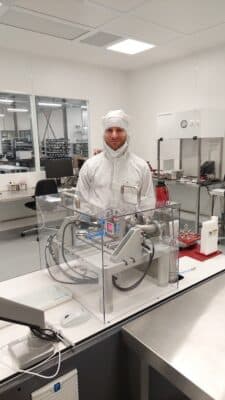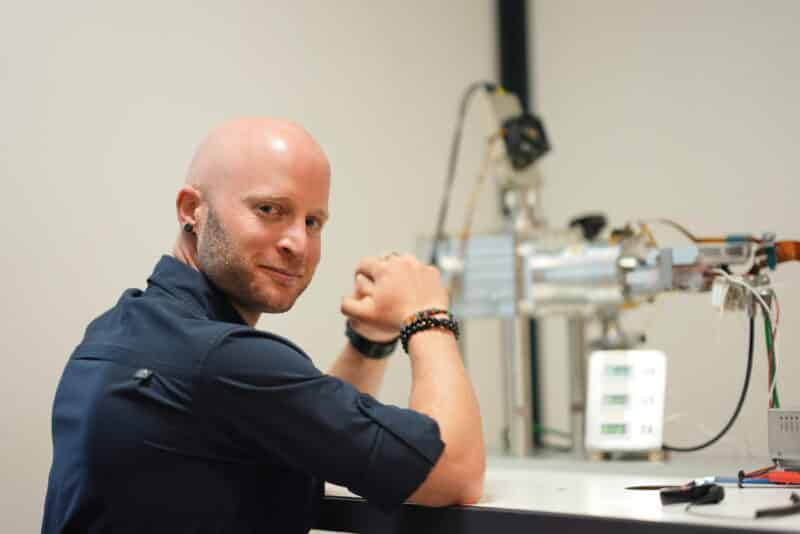Designing tooling for an electron microscope at micron-level precision was a challenge for South-African Rosca de Waal, System Designer Mechanics at Sioux Technologies. Which is why he took the Design principles for precision engineering course at the High Tech Institute. ‘All these lightbulbs started going off in my head.’
‘I never realized how much I needed work-life balance before I came here’, Rosca de Waal exclaims when asked about the move from his native South-Africa to Eindhoven. Of course, he’s excited to work as a System Designer Mechanics at Sioux Technologies. Yet what most struck him are the better working conditions.
The Stellenbosch University graduate now works on an electron microscope for Thermo Fisher. In South-Africa he built earth-observation telescopes for the company Simera Sense, yet his new project at Sioux required a higher level of precision engineering than he was used to. Which is why he joined the Design principles for precision engineering course at the High Tech Institute.
‘It’s quite a daunting and intimidating task if you need to adjust something to within micron-level precision’, he says. ‘It’s not just the small scale at which we work. It’s the environment inside the microscope that makes it so much more challenging. You’ve got very limited space inside of it, and on top of that you’re working under a high vacuum. The environment inside also needs to be very clean and the precision needs to be maintained at varying temperatures.’
Sioux is co-designing Energy Dispersive X-ray detectors for Thermo Fisher electron microscopes. Electrons hitting the sample directly and indirectly generate an image, but these electrons also generate X-ray’s. The EDX detector detects the X-rays that come off the sample, and converts them into material analysis. This offers a range of design challenges. The detector need to be aligned with the pathway of the X-rays, and it needs to be in a precise orientation with respect to the sample and the pole pieces.
‘The closer the detector is to the pole pieces, the more X-rays you will collect and the faster you will get enough data, before the electrons damage the sample’, says de Waal. ‘But there’s a risk to this, because you don’t want to touch the sample or the pole piece. That’s a very big risk. You want to be as close as possible but still leave some room for error. All of that we need to do at the micron-scale.’
''But this training really helped me open my mind. Something can be quite simple once you just grasp all the basic concepts underlying it.''
Multidisciplinary
Sioux is a company that works on complex multidisciplinary systems development. The acquisition of Sioux CCM ten years ago, allowed them to build up their expertise in mechanical engineering. Today de Waal’s work builds on this multidisciplinary team.
‘For the EDX detector, I was involved with the tooling and mechanical alignment of the sensors’, he says. ‘We have our electrical team, who designed the electronics. Sioux also developed the software. This was a multidisciplinary project. We even have a Mathware department, that consists of a team of physics and mathematics PhD’s, that helped us calculate stiffness and rigidity. That was important because we, for example, couldn’t apply too much stress while inserting the sensors. We had a tolerance budget which we needed to stay within. If not, that could lead to a worst-case scenario. We used all the skills you can find within Sioux in this project.’
Learning how to deal with these challenges is why de Waal took the course Design principles for precision engineering at High Tech Institute. ‘Of course, my colleagues gave me advice. But this training really helped me open my mind. Something can be quite simple once you just grasp all the basic concepts underlying it.’

‘A whole new world opened up for me,’ Rosca de Waal
Flexures
One element that had a prominent place in the course were flexures. ‘I had come across flexures before’, says de Waal. ‘But I never needed to use them with such high precision. At my previous company, of course, we also had to design with a high degree of precision. There we used flexures to remove things like stick-slip. We used them to smoothen our adjustment, but not to limit and make the adjustment this accurate. In the electron microscope project, however, the flexures needed to fit into this intricate system, where multiple factors had to be kept in mind, such as temperature, position, adjustment accuracy and resolution.
You can actually achieve a high level of precision under those conditions with just flexures and leaf springs if you know how to use them. We often use different metals here, in combination with thermal expansion, to try and account for displacement. If you use flexures correctly, you can account for this within the requirements that you need.
This was a whole new world that opened for me. These very simple things can be designed on a small scale to fit into small places. On top of that, they will work perfectly in a vacuum environment, because they’re just metal. You don’t need special lubricated grease for ball bearings for example.’
''I didn't know up to what resolution and thinness of metal they could machine these parts. But by giving us a range of practical examples, we learned this information very quickly.''
Five lecturers and several external experts
‘The course gave me very practical knowledge on flexures’, de Waal continues. ‘Before I took it, for example, I didn’t know up to what resolution and thinness of metal they could machine these parts. But by giving us a range of practical examples, we learned this information very quickly.’
The course lasted one week, with a morning and evening session every day. Five lecturers taught the students. Besides that, external experts joined certain classes, to illustrate the theory with examples from their respective fields and industries. This meant the sessions were dotted with practical examples.
‘It helps you make connections’, de Waal says. ‘Suddenly you realize, “oh wow you can also apply this there.” One person explained how they used a simple flexure to sort electronic components in a factory, and then another person came along and explained how they used similar principles to build a fully functioning robot arm. That was quite insightful. The lecturers themselves were also well versed in their field.’
''...all these light bulbs started going off in my head. I suddenly started understanding the project I was working on a deeper level''
Business cards
Besides practical examples, the students also did many exercises. ‘They gave us business cards with these blocks with push pins’, says de Waal. ‘You could then play around to really get a feel of the idea. It’s something so simple, just some paper and some blocks. But with them you can better understand how, for example, leaf springs work. That really helped me to get a feel and understanding of certain concepts. It helps when you can physically feel how something works. The lecturers also 3D-printed some examples for the class. During the second half of the fifth day, we also had to design something. It’s one thing to learn the theory, but another to actually design based on the theory. During these couple of hours, we could try and apply all the knowledge we learned. The lecturers would guide you if you got stuck or would challenge your way of thinking. The entire structure of the course was well thought through.’

Rosca de Waal – Sioux Technologies.
De Waal’s class was mostly composed of people from the high-tech industry around Eindhoven, but international participants also joined, including students from France, Italy and even Saudi-Arabia. Many of those were from the biomedical industry.
Since taking the course in September of last year de Waal is positive about the effects it has had on him and his career. ‘Before I took it, I didn’t have a proper, deeper understanding of these principles’, he says. ‘But once I did, all these light bulbs started going off in my head. I suddenly started understanding the project I was working on a deeper level.’
This article is written by Tom Cassauwers, freelancer for High-Tech Systems.
Recommendation by former participants
By the end of the training participants are asked to fill out an evaluation form. To the question: 'Would you recommend this training to others?' they responded with a 9.5 out of 10.

